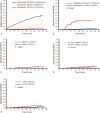Incidence and Outcomes of Patients With Oral Cavity Squamous Cell Carcinoma and Fourth Primary Tumors: A Long-term Follow-up Study in a Betel Quid Chewing Endemic Area
- PMID: 27015170
- PMCID: PMC4998365
- DOI: 10.1097/MD.0000000000002950
Incidence and Outcomes of Patients With Oral Cavity Squamous Cell Carcinoma and Fourth Primary Tumors: A Long-term Follow-up Study in a Betel Quid Chewing Endemic Area
Abstract
The aim of this study was to explore the incidence and outcomes of patients with oral cavity squamous cell carcinoma (OSCC) and fourth primary tumors (PTs) in a betel-chewing endemic area.We retrospectively examined the records of 1836 OSCC patients who underwent radical tumor resection between 1996 and 2014. The outcome measures included the incidence and number of multiple PTs, the main risk factors, and their associations with overall survival (OS).Of the 1836 patients, 1400 (76.3%) had a single PT, 344 (18.7%) a second PT, 67 (3.6%) a third PT, and 25 (1.4%) a fourth PT. Univariate analyses (log-rank test) identified the following factors as significantly associated with a fourth PT: simultaneous first and second PTs, betel quid chewing, buccal subsite, and pT3-4 status. After allowance for the potential confounding effect of other risk factors, all of these factors retained their independent prognostic significance in stepwise multivariate analyses, the only exception being betel chewing. The incidences of second, third, and fourth PTs at 5 and 10 years were 20.2%/34.6%, 4.0%/8.6%, and 1.0%/2.3%, respectively. The 5 and 10-year OS rates (calculated from the diagnosis of each PTs) for patients with a single, second, third, and fourth PTs were 68%/61%, 43%/37%, 45%/39%%, and 30%/30%, respectively (P < 0.0001). Among patients with a fourth PT, those who underwent radical surgery showed a significantly higher 3-year OS than those who did not (57% vs 13%; P = 0.0442).Fourth PTs are rarely observed in OSCC patients in a betel quid-chewing endemic area. Long-term survival rates of patients treated with radical surgery seems acceptable, being 4-fold higher than their counterparts.
Conflict of interest statement
This study did not receive any specific funding. The authors report no conflicts of interest.
Figures



Similar articles
-
Survival of second and multiple primary tumors in patients with oral cavity squamous cell carcinoma in the betel quid chewing area.Oral Oncol. 2007 Sep;43(8):811-9. doi: 10.1016/j.oraloncology.2006.10.003. Epub 2006 Dec 14. Oral Oncol. 2007. PMID: 17174143
-
Surgical outcomes and prognostic factors of oral cancer associated with betel quid chewing and tobacco smoking in Taiwan.Oral Oncol. 2010 Apr;46(4):276-82. doi: 10.1016/j.oraloncology.2010.01.008. Epub 2010 Feb 6. Oral Oncol. 2010. PMID: 20138564
-
Surgical outcome in patients with oral verrucous carcinoma: long-term follow-up in an endemic betel quid chewing area.ORL J Otorhinolaryngol Relat Spec. 2009;71(6):323-8. doi: 10.1159/000267306. Epub 2009 Dec 18. ORL J Otorhinolaryngol Relat Spec. 2009. PMID: 20029242
-
The oral health consequences of chewing areca nut.Addict Biol. 2002 Jan;7(1):115-25. doi: 10.1080/13556210120091482. Addict Biol. 2002. PMID: 11900631 Review.
-
Head and neck cancer in the betel quid chewing area: recent advances in molecular carcinogenesis.Cancer Sci. 2008 Aug;99(8):1507-14. doi: 10.1111/j.1349-7006.2008.00863.x. Cancer Sci. 2008. PMID: 18754860 Free PMC article. Review.
Cited by
-
Systemic and Local Effects Among Patients With Betel Quid-Related Oral Cancer.Technol Cancer Res Treat. 2022 Jan-Dec;21:15330338221146870. doi: 10.1177/15330338221146870. Technol Cancer Res Treat. 2022. PMID: 36575633 Free PMC article. Review.
-
Detection of Merkel cell polyomavirus in multiple primary oral squamous cell carcinomas.Odontology. 2023 Oct;111(4):971-981. doi: 10.1007/s10266-023-00807-y. Epub 2023 Mar 25. Odontology. 2023. PMID: 36964865 Free PMC article.
-
Indicators for secondary carcinoma in head and neck cancer patients following curative therapy: A retrospective clinical study.Mol Clin Oncol. 2020 May;12(5):403-410. doi: 10.3892/mco.2020.2004. Epub 2020 Feb 26. Mol Clin Oncol. 2020. PMID: 32257195 Free PMC article.
-
The strength of organ, tissue, and body field effects determines the frequency of all neoplasia.Ann N Y Acad Sci. 2025 Apr;1546(1):11-22. doi: 10.1111/nyas.15306. Epub 2025 Mar 17. Ann N Y Acad Sci. 2025. PMID: 40096640 Free PMC article. Review.
-
A retrospective study on the prognostic value of preoperative C-reactive protein to albumin ratio in patients with oral cavity squamous cell carcinoma.PeerJ. 2020 Jun 16;8:e9361. doi: 10.7717/peerj.9361. eCollection 2020. PeerJ. 2020. PMID: 32587804 Free PMC article.
References
-
- Hayat MJ, Howlader N, Reichman ME, et al. Cancer statistics, trends, and multiple primary cancer analyses from the Surveillance, Epidemiology, and End Results (SEER) Program. Oncologist 2007; 12:20–37. - PubMed
-
- Lin K, Patel SG, Chu PY, et al. Second primary malignancy of the aerodigestive tract in patients treated for cancer of the oral cavity and larynx. Head Neck 2005; 27:1042–1048. - PubMed
-
- León X, Quer M, Diez S, et al. Second neoplasm in patients with head and neck cancer. Head Neck 1999; 21:204–210. - PubMed
MeSH terms
LinkOut - more resources
Full Text Sources
Other Literature Sources
Medical

